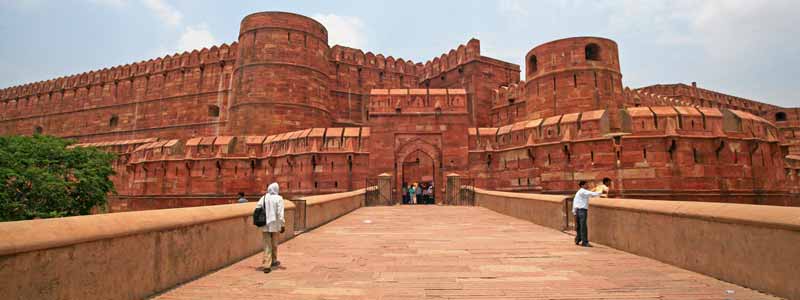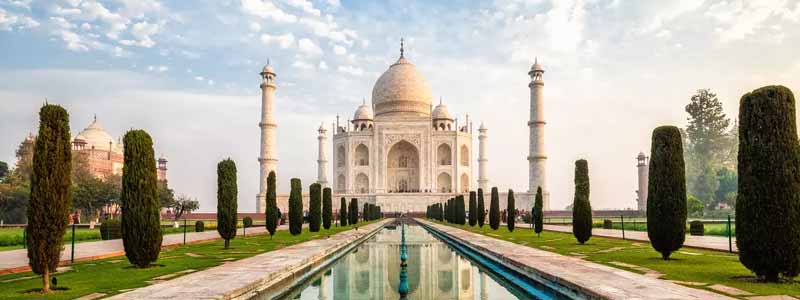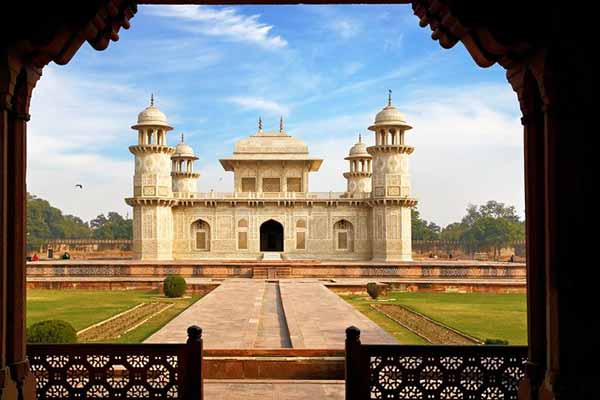Top 10 Places To Visit In Agra is world-renowned for being the home of the iconic Taj Mahal and while many travelers will make the journey to this Indian city just to marvel at the marble walls and landscaped gardens of the country’s most instantly recognizable sight, there are many more great places to visit in Agra too.
After gazing in awe at the spectacular Taj Mahal, stay around in the city for longer to explore the rest of the sites in Agra.
This is a city with an incredibly rich history and in Agra, you can find sprawling forts, resplendent tombs and exquisite palaces alongside a vibrant culture, lively markets and excellent cuisine.
To help inspire you to venture beyond the Taj Mahal, here are the Top 10 Places To Visit In Agra.

Agra Fort
There’s probably no better place to start your visit than at the Agra Fort, which, as the name suggests, got its start as a defensive structure for past rulers. But there is so much more to this UNESCO World Heritage Site than just its impressive red sandstone facade Agra Tour Packages.
It’s jam-packed with important palaces and historical monuments, all of which can be enjoyed during a comprehensive tour. With so many amazing spots in and around the complex, you can easily spend the whole day exploring!
Stroll through the beautifully manicured gardens of Anguri Bagh, or visit the spectacular gold-accented halls of Diwan-I-Am, where Emperor Shah Jahan used to meet with his citizens Top 10 Places To Visit In Agra.
Admire the striking architecture and impressive size of the Jahangir Palace, which once housed the women of the royal family; or check out the striking octagonal tower of Musamman Burj, which offers perfect views of the nearby Taj Mahal.
And be sure to stop by the Nagina Masjid, a magnificent mosque best known for its three beautiful white domes. Spend a few hours (or even a day) exploring the compound; it’s a great way to start exploring the city’s phenomenal history!

Taj Mahal
If you’re looking for places to visit in Agra, the Taj Mahal will certainly top the list. But it is certainly a place that lives up to its hype!
This stunning monument was commissioned by Shah Jahan as a mausoleum for and tribute to his wife, Mumtaz Mahal. It is often celebrated as a symbol of enduring love, and its iconic domed silhouette has long drawn visitors to India.
While the Taj itself has plenty of wonders to explore, it’s also worth taking some time to explore the larger complex around it. The Taj Mahal Gardens are particularly notable not only for their beauty, but also for their symbolism Top 10 Places To Visit In Agra.
With their intricately arranged plants and water features, they are designed to emulate the Islamic description of Paradise. And as you wander around the area and take in the full view of the towering marble dome, the comparison may seem very apt!
There are plenty of guided tours of the compound, which can often be combined with trips to the Agra Fort. Even if you’re staying in other areas, you can easily travel to this beloved site.
There are a variety of Taj Mahal tours departing from Delhi (four hours north) or Jaipur (four hours to the west), ranging from shorter day trips to multi-day adventures.
Some standout options include a private tour by car from Jaipur, with additional stops at the Tomb of Itimad-ud-Daulah and Agra Fort, or an express train from Delhi, which allows you to take in the sights and experience the famous local railways.
Whichever option you choose, you’ll be able to enjoy the splendor of a truly magnificent place up close, and that alone is worth the journey.
Itmad-ud-Daula
Rough drafts are notorious for being less polished or attractive than their counterparts… unless, of course, it’s the Tomb of Itimad-ud-Daulah.
Sometimes referred to as “Baby Taj,” this beautiful mausoleum was often considered a precursor to its more famous counterpart. But it also boasts some pretty impressive details of its own, including beautiful towers and a distinctive square Top 10 Places To Visit In Agra.
Like the Taj, the building is made out of white marble and garnished with semiprecious stones, an impressive testament to the changing architectural styles of the empire.
Check out the inside to see the crypts belonging to Mirza Ghiyas Beg – who served the royal family for many years – and his wife, housed in a soaring chamber whose designs pay tribute to the area’s Perisian influence.
And keep an eye out for all of the other remarkable artistic details scattered around the interior, including beautiful paintings of plants and animals and colorful, eye-catching mosaics.
This splendid building is a great piece of architecture in and of itself, and a perfect stop as you make your way through all of the remarkable buildings in town.
Tomb of Akbar the Great
As the name suggests, the Tomb of Akbar the Great is the final resting place of one of the region’s most renowned emperors, and it’s a monument both to his work and the cultural norms of the time.
Located in the Sikandra suburb, this beautiful structure of marble and sandstone was commissioned by Emperor Akbar I, who oversaw significant civic and cultural advancements.
He is perhaps best known for helping to bolster the strength of the Mughal Empire, and the tomb pays tribute to his respected status, as well as his Muslim faith.
Its palatial exterior is only matched by the phenomenal designs on the inside. Jaw-dropping geometric designs in shades of blue and gold cover several walls, alongside beautiful floral patterns that wind over archways.
Through every door and around every corner, you’re treated to magnificent art that showcases the strong Islamic stylistic influence at the time. The surrounding grounds are also worth visiting, with a series of beautiful gardens to explore. Keep an eye out for the tame monkeys and deer!
Mehtab Bagh
For a slightly less bustling but still wonderfully immersive excursion, take some time to visit Mehtab Bagh.
Located just across the way from the Taj Mahal, this gorgeous park is one of the most tranquil places to visit in Agra, with fantastically symmetrical landscaping and plenty of green space to enjoy.
Of course, the Taj View Point is one of the main attractions, with incredible opportunities to view the monument at every angle and hour of the day (sunset, unsurprisingly, is a particularly popular option).
But you can also enhance your experience with some of the many excellent yoga classes held in the park. Drop by for sunrise or sunset, or book your session as part of a larger tour around the area.
Practice your favorite moves (or learn some new ones) with renowned local teachers, and experience this ancient art in the place it was born – and in the shadow of one of the country’s finest buildings.
It’s sure to be a mesmerizing experience for both mind and body!
Chini Ka Rauza
Since it was constructed in 1635, Chini Ka Rauza has served as a fantastic example of the area’s multicultural influences. This mausoleum stands out from its contemporaries because of the materials used in its design: porcelain tiles.
These beautiful blue pieces are believed to have come from China, a symbol of Agra’s past as a thriving trade hub. And if you look closely at the designs in and around the building, you’ll see plenty of design details from Perisa, as well as Afghanistan.
Stop by to see these fantastic elements up close, then head over to nearby attractions such as the Taj Mahal and Itimad-ud-Daulah.
Wildlife SOS
While the cultural offerings are spectacular, nature-lovers will still find plenty of places to visit in Agra. And Wildlife SOS is undoubtedly one of the most interesting and important of those spots, whether you’re an animal fanatic or just dipping your toe into the world of conservation.
This acclaimed organization and wildlife sanctuary celebrates the unique creatures in the area by fighting for their survival, with programs ranging from rehabilitation to anti-poaching initiatives.
If you’d like to learn more about the local wildlife and support a wonderful cause, you can visit some of the many rescue centers that they run in the area. Stop by the Agra Bear Rescue Facility to meet the sloth bears – over 130 of them live on the grounds!
These small, dynamic creatures have long been threatened by human activity, but at the sanctuary, you can watch them roam freely about the grounds, playing and socializing in small groups.
There’s even a special section set aside for weaning and raising orphaned cubs. Or check out the Elephant Conservation and Care Center – to visit the beautiful herds of rescued pachyderms.
After a lifetime of hard work in circuses or temples, these intelligent, emotional animals are finally free to swim, sun themselves, and enjoy life in open pastures.
A day spent watching them interact with their surroundings is one that you won’t soon forget! You can meet plenty of other local animals as well, from snakes and leopards to hyenas and barn owls.
If your visit leaves you feeling inspired, there are tons of great ways for you to get more involved. The organization offers plenty of opportunities for visitors, from conservation classes to volunteering opportunities.
Whether you’re feeding the animals, observing their daily behavior, or building exciting new toys for them to play with, you’ll have lots of chances to explore the world of wildlife rescues. So channel your inner Steve Irwin and head over for a visit!
Jama Masjid
Just across from the Agra Fort, Jana Masjid is a spectacular monument in its own right. As one of the largest mosques in India, it boasts a fascinating array of architectural gems, from massive domes to striking geometric designs.
Since its construction in the 17th century, it has been a focal point of the local Muslim community, and a renowned landmark all throughout the city.
Not only is it another wonderful example of Islamic architecture, but it also showcases the opulence and attention to detail that made so many of the area’s buildings famous. And because it is still an active mosque, you can learn all about the evolution of the religion during your visit.
Whether you’re drawn to the religious history, the design elements, or both, this iconic site is a must-see!
Sikandra Fort
Just next door to Emperor Akbar’s final resting place, Sikandra Fort boasts phenomenal designs and spectacular history.
Like the tomb itself, it was commissioned by the emperor before his death, so you can see many of the same architectural features encompassed in its impressive red facade.
You could easily spend an entire day just wandering the grounds, taking a crash course in the history of the empire’s cultural and artistic tastes.
Be sure to check out the four magnificent gates around the property, each with a unique style and function; and don’t miss out on the spectacular fountains!
Fatehpur Sikri
Just north of Agra, the town of Fatehpur Sikri is filled with remarkable buildings and interesting sites.
The town – whose name translates to “City of Victory” – was the capital of the Mughal Empire for a time during the late 1500s, and its design reflects the diverse influences on the area during that time.
The buildings are a unique blend of Hindu and Islamic styles, a result of the widespread religious tolerance and intellectual curiosity of the era.
Check out the striking ruins of various buildings that were once the center of the empire, including the Fatehpur Sikri Mosque, which was patterned after Mecca, and Buland Darwaza, an immense monument to military victory.
Buland Darwaza is particularly striking; it is one of the tallest gateways on the planet, and with its massive marble and sandstone structure towering above the surrounding buildings, it makes quite a vivid impression.
The structure was originally built by Emperor Akbar to commemorate his victory in Gujarat, and today, it serves as the entryway to the beloved Jama Masjid Mosque. You can also spend plenty of time simply wandering past the remains of various buildings around the site, ranging from administrative offices to temples.
Each and every one of them speaks to the deep and fascinating history of this remarkable city, and they’ll make you see the modern-day cities nearby in a whole new light.
